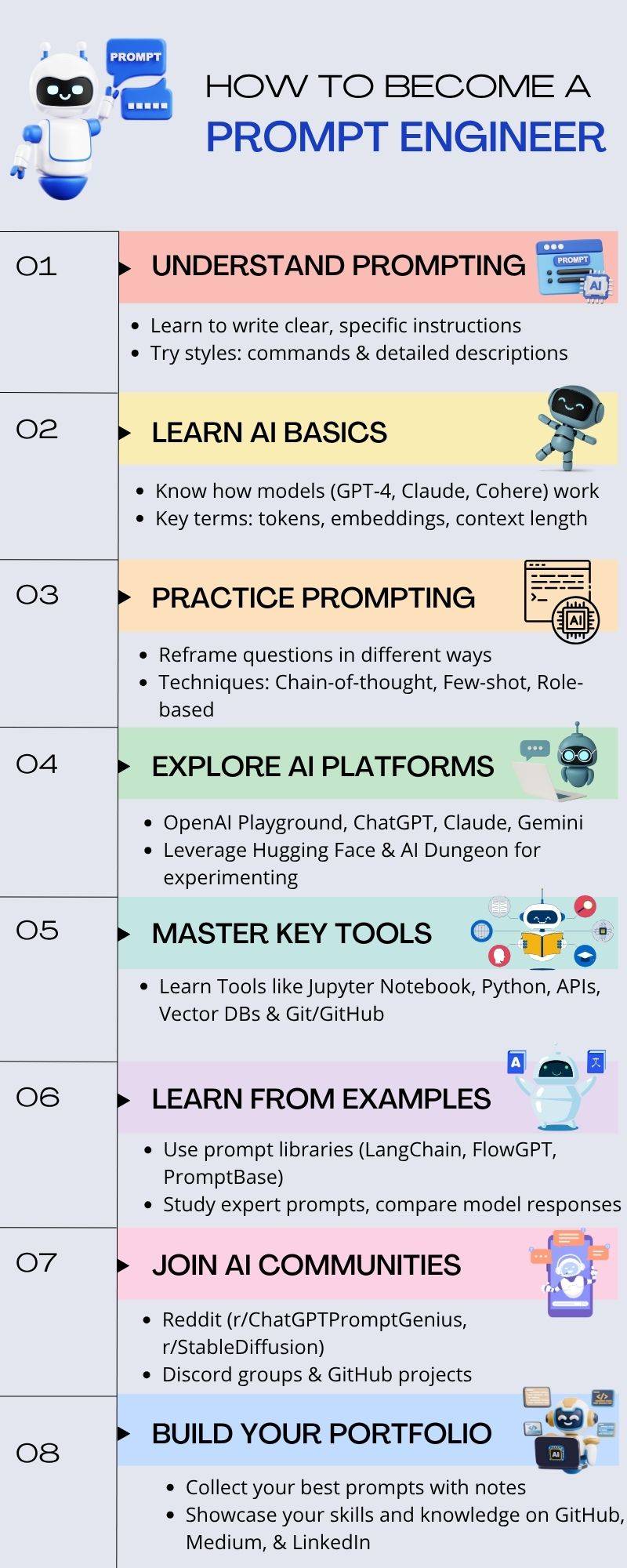How to Become a Prompt Engineer From Scratch!
3-4 years back, you might not have even heard of prompt engineering and what a prompt engineer might do. In the era of generative artificial intelligence (GAI), prompt engineers have become key in optimising the interaction between humans and advanced language models (GPT, Gemini, Claude, etc.). In this write-up, we will talk about prompt engineering, the role of a prompt engineer, top prompt engineering courses to take, and how to become a prompt engineer.

- What is Prompt Engineering?
- What is a Prompt Engineer?
- What Does a Prompt Engineer Do?
- Why is the Prompt Engineer Important in AI?
- Becoming a Prompt Engineer: Step-by-Step Guide
- Top Prompt Engineering Courses
What is Prompt Engineering?
Prompt Engineering means designing precise inputs, in the form of well-designed "prompts," and then generative AI models generate intended high-quality outputs.
It is a professional skill that demands clarity, creativity, domain understanding, and technical knowledge of AI model behaviour and constraints. Prompt engineering is not applied to structure the training data but is a technique to maximize the quality of AI's output during inference by carefully crafting model instructions.
Please note that being a prompt engineer does require creativity, critical thinking, and a deep understanding of AI capabilities.
Prompt Engineering is a constant process of experimentation, writing, executing, and refining prompts.
What is a Prompt Engineer?
A prompt engineer is a professional responsible for communicating with the LLMs. As a prompt engineer, your main role will be to design and optimise the instructions you give to the AI to get exactly what you need.
For example, instead of simply asking "give me innovative business ideas," you must structure your request more effectively:
You can write: "I need five out-of-the-box business ideas for the South East Asian market, primarily India, focused on creating environmentally sustainable child care products. I have a maximum initial budget of US$10,000. Consider current market trends and the growing need for digital solutions."
What Does a Prompt Engineer Do?
As a prompt engineer, your job is to write, execute, and refine prompts. You compare how a prompt works with different models, data, delimiters, and so on. You will also need to experiment with different prompts to find the ones that work best for your needs.
A prompt engineer should consider new or proven ways to enhance prompts and render them efficient for desired outputs. There is no fixed rule to generate prompts. Sometimes, shorter prompts outsmart the longer ones. It all depends on the task at hand, the context needed, and the desired outcome. You may need to be more specific, depending on the model you are using. Here are the primary tasks of a prompt engineer-
- Develop detailed prompts for the AI such that the context is clear to the AI and the desired output formats are clearly expressed
- Keep testing and tweaking the prompts as you go to get the best results
- Apply high-end techniques such as "chain-of-thought" prompting to enhance the AI's thinking abilities
- Combat the inherent bias in AI models and ensure safe outputs
- Deploy data scientists and developers that in turn will tell the AI applications and systems what they need to do with more precision
Why is the Prompt Engineer Important in AI?
AI models are very powerful, but their real utility depends on how one interacts with them. A good prompt makes all the difference, from getting a generic answer to receiving an extremely specific solution. Therefore, a good prompt engineer is really critical in harnessing this very feature of AI.
Companies invest millions into artificial intelligence, and they need experts who can effectively talk to machines. Therefore, prompt engineers are very important in areas such as technology, marketing, education, and automation.
Prompt engineers obtain the proper responses with these AI models, as intended, and create useful prompts.
Wondering how to specialise in AI and prompt engineering to become a proficient prompt engineer? Consider specialised AI training.
Becoming a Prompt Engineer: Step-by-Step Guide
If the above information got you hooked, then it is time for you to learn how to become a prompt engineer.
Understand What Prompt Engineering Is
Prompt 101! Learning how to write clear instructions for the AI model is the most crucial and fundamental step. Try different prompt styles, such as commands or detailed descriptions. Ensure your input is always easy to follow so that AI provides consistent outcomes.
Learn the Basics of AI and Language Models
Learn how large language models work, such as GPT-4: basic concepts like tokens, or small bits of text; embeddings, or the meaning of words in a mathematical sense; and context length, how much text AI can remember. It is also worth reading about the tools themselves for a deeper understanding of their models: OpenAI, Claude, and Cohere.
Practice Writing and Testing Prompts
Ask the same question many ways to see how answers change. Try methods including:
- Chain-of-thought prompting: guide AI step by step.
- Few-shot prompting: give examples in your prompt.
- Role prompting: ask AI to “be” a teacher, coder, or other roles.
Try Different AI Tools and Platforms
Build a habit of testing out prompts and settings in places such as OpenAI Playground. Have a little fun playing with ChatGPT, Claude, or Gemini-you get some very different results! Go to Hugging Face for open-source models. Want to play a creative story game with AI Dungeon? It should be good; give it a go!
Know the Key Tools for Prompt Engineers
Beyond writing prompts, experts use special tools:
| Jupyter Notebook |
To save your prompt tests |
| To write scripts and interact with AI |
|
| OpenAI and Hugging Face APIs |
For implementing prompts in applications |
| Postman |
Easy API testing |
| Vector Databases like Pinecone or FAISS |
Store and recall massive volumes of information for prompts. |
| Git or GitHub |
Collaborate with others. |
Learn from Good Examples
Check out prompt libraries like LangChain, FlowGPT and PromptBase. Analyse how experts write prompts and try changing them. Compare how different AI models answer the same prompt.
Join AI Communities
Join communities or groups like r/ChatGPTPromptGenius & r/StableDiffusion on Reddit, Project AI and Prompt Engineering Hub on Discord, to name a few. Chat with AI enthusiasts on Discord. Watch open-source AI projects on GitHub to learn the best tips.
Build Your Portfolio
Include a portfolio of your best prompts, with notes on why each was effective. Include changes or improvements in your prompts over time. List down your work on platforms like GitHub, Medium, or LinkedIn to show your skills.
Top Prompt Engineering Courses
You can take online prompt engineering courses to get more knowledge and skills concerning recent developments in this domain. These courses will let you master niche skills without breaking the bank.
| Course |
Duration |
Fee |
| 4 Hours |
Rs. 3,499 |
|
| Prompt Engineering for Data Analysis Python, Pandas, ChatGPT by Udemy |
14 Hours |
Rs. 619 |
| Large Language Models: Application through Production by Databricks |
On Demand |
Free |
| 1.5 hours |
Rs. 739 |
|
| 1 week |
US$99 (Audit for free) |



Name: Rashmi Karan
Education: M.Sc. Biotechnology
Expertise: IT & Software Entrance Exams
Rashmi Karan is a Postgraduate in Biotechnology with over 15 years of experience in content writing and editing. She speciali
Read Full Bio